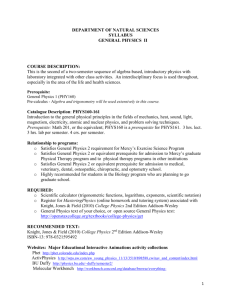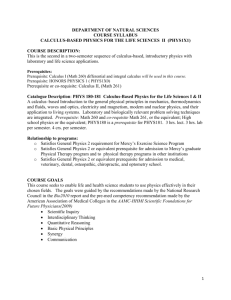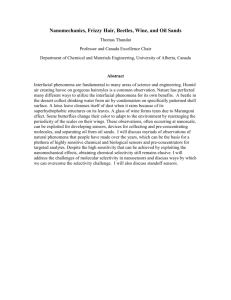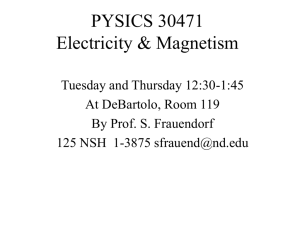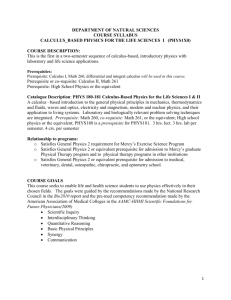syllabus - Doane College Physics Web Server
advertisement
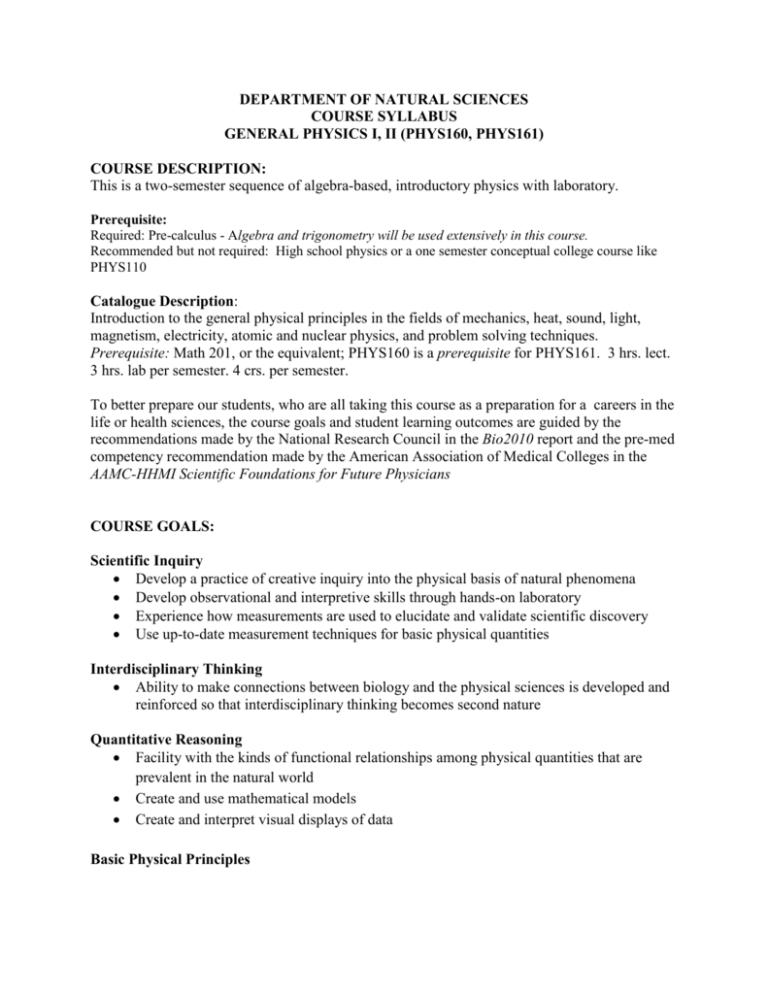
DEPARTMENT OF NATURAL SCIENCES COURSE SYLLABUS GENERAL PHYSICS I, II (PHYS160, PHYS161) COURSE DESCRIPTION: This is a two-semester sequence of algebra-based, introductory physics with laboratory. Prerequisite: Required: Pre-calculus - Algebra and trigonometry will be used extensively in this course. Recommended but not required: High school physics or a one semester conceptual college course like PHYS110 Catalogue Description: Introduction to the general physical principles in the fields of mechanics, heat, sound, light, magnetism, electricity, atomic and nuclear physics, and problem solving techniques. Prerequisite: Math 201, or the equivalent; PHYS160 is a prerequisite for PHYS161. 3 hrs. lect. 3 hrs. lab per semester. 4 crs. per semester. To better prepare our students, who are all taking this course as a preparation for a careers in the life or health sciences, the course goals and student learning outcomes are guided by the recommendations made by the National Research Council in the Bio2010 report and the pre-med competency recommendation made by the American Association of Medical Colleges in the AAMC-HHMI Scientific Foundations for Future Physicians COURSE GOALS: Scientific Inquiry Develop a practice of creative inquiry into the physical basis of natural phenomena Develop observational and interpretive skills through hands-on laboratory Experience how measurements are used to elucidate and validate scientific discovery Use up-to-date measurement techniques for basic physical quantities Interdisciplinary Thinking Ability to make connections between biology and the physical sciences is developed and reinforced so that interdisciplinary thinking becomes second nature Quantitative Reasoning Facility with the kinds of functional relationships among physical quantities that are prevalent in the natural world Create and use mathematical models Create and interpret visual displays of data Basic Physical Principles Recognize basic physical principles in a variety of natural processes at different scales, from the molecular to the organismal. Internalize sense making sufficiently to be able to apply foundational principles of change and interaction to the understanding of living systems. Synergy Be able to apply multiple physical principles to more complex natural processes, as is typically manifest in living systems. Communication Be able to discuss physical phenomena using appropriate physics terminology Be able to articulate sense-making in discussion of physical processes in nature STUDENT LEARNING OUTCOMES: Quantitative Reasoning 1. Express and analyze natural phenomena in quantitative terms that include an understanding of the natural prevalence of basic functional relationships Proportional relationships Linear relationships Quadratic relationships Inverse relationships Inverse square relationships Logarithmic/exponential relationships Periodic relationships 2. Use of units of measurable quantities; dimensional analysis and unit conversion 3. Identify functional relationships from visually represented data Interpret graphical representations of data o Physical meaning of Slope Area under curve Y-intercept Describe graphical functional relationships in mathematical form Interpret frequency spectrums • Draw and interpret Visual display of Vectors o Motion Diagrams o Free-body diagrams o Extended body diagrams Vector fields o Electric fields o Magnetic fields 4. Modeling Be able to mathematically model pertinent aspects of a natural phenomenon in terms of functional relationships of measurable quantities Make inferences about natural phenomena using mathematical models Be able to articulate in words what relationships a mathematical model is expressing Be able to discuss limitations of models, the simplifications and approximations made, and the temporal and spatial scale in which it is relevant. 5. Quantify and interpret changes in dynamical systems Kinematics Biomechanical dynamics • Exponential growth and decay Damping Capacitance circuits Radioactive decay Oscillations o Simple harmonic motion Resonance Waves Electric circuits Electromagnetic Induction Waves Scientific Inquiry 1. Demonstrate creative inquiry into the physical basis of natural phenomena 2. Demonstate observational and interpretive skills Hands-on activities in virtually every class Bodies-on activities using kinesthetic sense 3. Operate basic laboratory instrumentation for scientific measurement or field experiences. Computer-acquisition and analysis of data using: 2D Force Plates, Force sensors, Motion sensors, 3 D accelerometers, goniometers, temperature sensors, pressure sensors, sound sensors, voltage and current sensors, magnetic field sensors, light sensors, UV sensors, infrared sensors, Geiger Counter sensor Video analysis of visibly dynamic phenomena Optic s benches, multimeters, 4. Articulate reasoning to explain or question data. 5. Raise scientific questions and hypotheses, design experiments, acquire data, perform data analysis, and present results. Guided inquiry during class Student projects 6. Demonstrate the ability to search effectively, to evaluate critically, and to communicate and analyze the scientific literature. Literature search and review as part of student project. Basic physical principles 1. Demonstrate understanding of mechanics as applied to living systems • Understand the interrelationships among work, energy, force, and acceleration. o How you move objects o How you get moved by objects (as a passenger) o How you move yourself (locomotion) • Understand the interrelationships among rotational work, rotational energy, torque, and angular acceleration o How engagement of your muscles moves your limbs • Apply knowledge of mechanics to movement in biological systems at various scales, from the molecular to the organismal. o How your limbs enable you to move objects and move yourself o How food energy is converted into muscular work 1. Demonstrate knowledge of the principles of electricity and magnetism and its application to biological systems Electrical forces, fields and potential: o Endogenous: cell membrane, action potentials, epithelial, intracellular o Electrocytes and electric field detection by fish o Electrostatic basis of chemical structure and function o Diagnostic – ECG, EMG, EEG o Therapeutic – Wound healing, electroporation, ionosphoresis, defribillation Electric current and circuits Nerve conduction Resistivity/Impedance of bodily tissues, GRS, body fat composition Electrical Safety: household and therapeutic Magnetism and Electromagnetic induction o Diagnostic and therapeutic techniques using magnetism: MRI, bone repair o Endogenous magnetic fields of living systems o Magnetic sensing by animals o Electrical power generation Electromagnetic waves o Natural and manmade sources and receivers at all scales of the spectrum 3. Demonstrate knowledge of wave generation and propagation and the application to living systems Matter Waves o Sound, Hearing, and Speech o Diagnostic and Therapeutic Ultrasound Electromagnetic Waves o Bodily effects at all scales in the electromagnetic spectrum o Diagnostic, therapeutic, and research uses at all scales in the spectrum o In everyday human use Geometric optics o Image formation in the eye and in microscopes o Fiber optics in medical scopes Wave optics o Image resolution in the eye and in microscopes o X-ray diffraction for biomolecular structure determination 4. Demonstrate knowledge of the principles of thermodynamics and fluid motion and the application to functional properties of tissues and organisms. . Heat transfer mechanisms and role of evaporation in the body Entropy, life, and energy efficiency Fluids and Pressures in the Body Blood pressure and vascular blood flow Lung pressures and breathing Random Walks, Diffusion, and Osmosis Effect of temperature on enzymes activity Metabolic rate and caloric requirements 5. Demonstrate knowledge of principles of quantum mechanics and nuclear physics and the application to biological systems. Wave particle duality as a basis for atomic and molecular energy levels and orbitals in biochemical structure and function, Quantum basis of biomedical investigative tools - spectroscopy, lasers, MRI Atomic/molecular energy levels and the origin of light and ionizing radiation Interaction of electromagnetic radiation with atoms and molecules of living systems. Radioactivity -isotopes as biological tracers Biological effects of nuclear radiation Nuclear fission and fusion for educated citizenship Synergy of principles in complex living systems (Selected Examples) 1. Physical basis of biochemical processes Apply principles of electrostatics, quantum mechanics, and thermodynamics to: Ionic and covalent bonding, Van derWaals interactions, hydrogen bonding Hydrophobicity and hydrophilicity driving molecular association. Structure of biological macromolecules and the effect of structure on properties. Biosynthesis: DNA, RNA transcription, self assembly, protein folding Energy storage in fatty acids and ATP and the transduction to functional activity Spontaneity of biochemical processes 2. Physical principles applied to the function of cells, tissues, organs, and organisms. o Explain physical basis of aspects of cellular function: o Energy conversion and metabolism o Membrane structure and function o Cell transport and storage o Molecular motors, muscle contraction and cell motility o Cell cycles and cell death o Explain physical basis of functional properties of tissues and organs. o o Organization of multi-cellular organisms, systems biology o Elasticity/Injury of Body Tissues o Respiratory System o Circulatory System o Nervous System Apply physics principles to biomechanics and exercise o Food energy conversion into muscular work o Gait analysis o Biomechanics to optimize sports technique o Exercise equipment design for optimal muscular engagement o Ergonomic considerations in human movement 3. Explain the physical basis of the mechanisms by which organisms sense and control their internal environment, sense and respond to their external environment. Energy in bodily processes Homeostasis, feedback Thermal regulation of the body Vestibular apparatus - Balance Reception and transduction of receptor signals Eyes and Vision Ears and Hearing Cutaneous receptors and proprioceptors Signaling - Inter- and intracellular communication 4. Explain the physical basis of possible mechanisms of occupational and physical therapy modalities o Traction o Electrical Stimulation – biofeedback, repatterning, muscular strengthening, tissue repair, pain management, wound healing o Therapeutic heat and cold o Therapeutic ultrasound o Laser light therapy o Transdermal drug delivery (ionphoresis and phonophoresis) o Vibration/Rhythm (rocking, swinging, vibration plate) o Aquatics and hydrotherapy 5. Apply physics principles to medical treatment and diagnostic tools Imaging (ultrasound, x-rays, Cat scan, MRI, infrared, radioactive tracers, PET) Surgical or tumor destruction (cauterization, laser, gamma knife, electroporation) Nuclear medicine Function replacement (heart, limb, joint) Electrical (ECG, EMG, EEG, GRS, nerve conduction) 6. Apply physics principles to biomedical and biophysics research techniques Electrophoresis, chromatography, DNA analysis Voltage dyes, ion patch clamp Fluorescent microscopy Centrifuge Atomic force microscopy Optical tweezers Spectroscopy 7. Apply physics principles to health field specializations o Dental o Decay detection o Ultrasonic cleaning o Chewing mechanics , TMJ o Tooth damage and repair o Veterinary o Distinctive animal locomotion and physiology o Distinctive animal communication o Distinctive sensing; prey detection, magnetic sensing o Extreme environment coping mechanisms 8. Apply physics principles to living on the earth, in the modern world o Climate effects, atmosphere, global warming, hurricanes, tornados, earthquakes o Electromagnetic effects: Lightning, magnetic storms, man-made electromagnetic fields, polar auroras, earth’s magnetic and electric fields o Electrical appliances and computer devices o Shelter/clothes o Transportation o Communication 9. Apply physics principles to consider possible mechanisms for alternative and complementary wellness approaches Acupuncture Bodywork (massage, cranial sacral, chiropractic, reflexology, structural integration, applied kinesiology, Reiki, therapeupic touch, dance) Somatic techniques (yoga, qiqong, tai chi, Gyrotonic, Alexander, Feldenkrais, pilates) Mind/Body (visualization, prayer, hypnosis, meditation, humor/laughter, placebo effect) Sound (music therapy, bi-aural entrainment, chanting) Electromagnetic ( magnets, bio-field imaging, electrodermal testing, bioresonance, earth grounding) Light (full spectrum, laser, color) Accredited alternative health disciplines (naturopathy, osteopathy, oriental medicine) Others (homeopathy, iridology, aromatherapy, crystal healing, flower essences) COURSE COMPETENCIES: At Mercy College, we want to ensure that the student will be able to effectively compete for jobs and careers in an increasingly complex world. Therefore, the College has focused on six foundational skills that we feel will help students achieve greater success in college as well as in their career. The student will be expected to meet minimum levels of achievement for graduation in these six competencies: Written Communication Oral Communication Critical Thinking Critical Reading Quantitative Reasoning Information Literacy Written Communication: Students’ writing skills will be measured by their ability to articulate their understanding in writing on exams, in project presentations, and in online discussions. Oral Communication: Students’ oral communication skills will be measured by the quality of their engagement in class discussion and collaborative group work, especially during lab activities. Students will be expected to orally articulate their reasoning for their predictions and interpretations of data. Critical Thinking: Students’ critical thinking skills will be measured by the process of inquiry encouraged by the active classroom activities, and by their self-directed projects. Critical Reading: Students’ critical reading skills will be measured by their ability to critically review and evaluate online resources of information and other students’ written work. Quantitative Reasoning: Quantitative reasoning is a pervasive part of this course. Students will have to use mathematical models of functional relationships of measurable quantities, analyze data quantitatively, and be able to interpret visual displays of quantitative data. Information Literacy: Students will be researching physics topics of their own choosing. REQUIRED TEXT: Knight, Jones & Field (2010) College Physics 2nd Edition Addison-Wesley with accompanying Student Workbook, vols. 1 & 2, and code to register for Mastering Physics (online homework and tutoring system). Required: Calculator (scientific- trigonometric functions, exponentials, logs, etc.) COURSE ACTIVITIES This course is taught in a “workshop” style where traditional lecture, lab, and recitation type activities are integrated. Every class will include a variety of components. Students will be guided to consider what gaps may exist in their present understanding of the natural phenomena under consideration. Students will work collaboratively in groups within a process of guided inquiry. Student groups will share their predictions and thinking with other groups by using group whiteboards. Students will experience hands-on exploration of natural phenomena, often using their own bodies for kinesthetic and other sensory input. Students will collect data using computer interfaced sensors, and then interpret and analyze the tabular and graphical data output. Students will use video for computerized motion analysis. Educational interactive simulations, both in class and for online homework, will be used to explore concepts concerning those aspects of topics that are not visibly apparent. Students will work collaboratively in groups to practice applying newly learned physics concepts to superficially different or increasingly complex scenarios. Group work is done on group whiteboards. Extensions of those scenarios may be given for individual practice at home. Further individual practice applying physics concepts will be available using the workbooks that accompany the text and the online Mastering Physics online tutorial and homework system that includes the end of chapter questions from the text. The text will provide additional perspectives and will reinforce and supplement the material covered in the class activities. Frequent short quizzes, either online or in class, will give feedback to students about their progress. The students will be self directed with a project, of which the topic will be of their choosing, within the guidelines of their instructor. They will post their project online for commentary and discussion by other students. OUTCOME ASSESSMENT Exams: 50% Example: 30% 4 topic exams – the lowest exam score may be dropped 20% Cumulative Final Exam Projects/Papers: 20% Example: 15% Submitted in stages online 5% Discussion and comments on each others’ projects online Homework: 15% Example: 10% Mastering Physics online 5% Workbook, Interactive Website comments, and Homework related to class activities Class Activities: 15% Example: 5% Attendance and Effort 5% 5% Quality of participation 5% 5% Quizzes based on previous class activities Assessment category percentages may vary slightly with instructor. COURSE POLICIES 1. Attendance Policy – It is assumed that a student will attend all classes for which he/she is registered. Ceasing to attend classes for three consecutive class meetings without contacting the instructor will result in the issuance of a grade of “FW” which indicates “stopped attending.” This grade of “FW” will be calculated into the student’s GPA as an “F” and may result in dismissal. In addition this status will be reported to The Office of Student Services and may result in a reduction of financial aid monies. Because this course is participatory in nature and has integrated lab and group activities, attendance is necessary to do well in the course. Expect lack of attendance or frequent lateness to be reflected in the course grade. 2. Cheating and Plagiarism – Cheating and plagiarism are contrary to the purpose of any educational institution and must be dealt with most severely if students’ work is to have any validity. An instructor who determines that a student has cheated on a test or assignment will at a minimum give a zero for that item and may give a failure for the course. Normally the matter is handled between the instructor and the student, but either party to ensure fairness may consult the department chairperson. Suspicion of cheating on exams (e.g. as when two students sitting next to each other have unnaturally similar answers) will result in another exam taken in place of the original by all parties involved. Plagiarism, which is the appropriation of words or ideas of another without recognition of the source, is another form of cheating. An instructor who determines that a student has plagiarized will give a zero for the paper or project and may give a failure for the course. Both cheating and plagiarism are grounds for dismissal from the College. Any action taken regarding cheating or plagiarism is subject to the Academic Grievance Policy outlined above and in the Student Handbook. 3. Cell Phone Use – Cell phones should be turned off prior to the start of class. Students that do not abide by this policy may be asked to leave for the day and will receive an unexcused absence. Resources Science Learning Center - in Dobbs Ferry Learning Center Free Physics Tutoring - Hours to be announced For Tutoring needs, email: tutoring@mercy.edu BIBLIOGRAPHY Tuszynski ( 2001). Biomedical Applications of Physics, Wiley Newman, Jay (2008). Physics of the Life Sciences, Springer Hewitt, Paul (2002). Touch This! Conceptual Physics for Everyone, Addison-Wesley Hewitt, Paul (2010). Practicing Physics, Conceptual Physics, Addison-Wesley Hewitt, Paul (2010). Conceptual Physics 11th edition, Addison-Wesley Cameron, Skofronick, Grant (1999). Physics of the Body, Medical Physics Publishing Urone, Peter (2001). College Physics 2nd Edition, Brooks Cole Urone, Peter (1986). Physics with Health Science Applications, Wiley Wisneski, L. (2009). The Scientific Basis of Integrative Medicine, CRC Press
